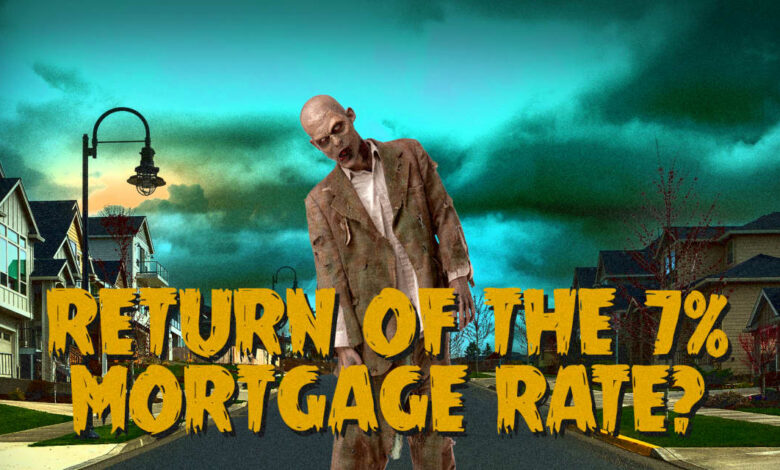7% mortgage rates are back but rates will fall through the rest of the year

Haunted by high prices and low inventory, the U.S. housing market can sometimes feel like a horror movie to prospective home buyers. Now there are fears that one villain is back from the dead: the 7% mortgage rate.
After mortgage rates surged in March 2022, when the Federal Reserve embarked on a series of interest rate hikes to quell inflation, the 30-year rate reached towards 8% in October 2023.
Mortgage rates began falling again last December, when they dipped below 7% for the first time in four months. Forecasters suggested the 7% rate was dead and gone, putting out predictions that rates would fall below 6% by the end of 2024, but the 7% rate may have some life in it yet. U.S economic growth is still running at a pace that’s hotter than expected, and that’s continuing to keep overall interest rates and mortgage rates up.
But fear not: Rates will still fall in the back half of this year, economists tell MarketWatch.
Mortgage rates rose over the last week after data indicating consumer prices and wholesale prices rose last month, and the job market is thriving. With the Federal Reserve now expected to delay its interest rate cuts until the second half of the year, mortgage rates are once again rising across the board.
30-year is already past 7%, according to some sources
Mortgage lenders set their rates based on a number of factors, which include the borrower’s credit score, their loan-to-value ratio and other market factors. And that causes considerable variation: The 30-year mortgage rose to 7.14% as of Friday afternoon, according to one survey by Mortgage News Daily.
Freddie Mac, which bases its estimates on thousands of mortgage applications, said its measure showed rates jumping 13 basis points to 6.77% as of Feb. 15. And the Mortgage Bankers Association, whose data comes with a one-week lag, indicated that the average contract rate for a 30-year mortgage was at 6.87% last week, with the 30-year jumbo loan already hitting 7%.
“What’s happened right at the moment is that there have been some strong data releases that people are eagerly relating to, including the CPI itself, and they’re concluding that the Fed is going to change the pace or timing at which they would cut interest rates,” Doug Duncan, chief economist at Fannie Mae, told MarketWatch in a phone interview on Friday.
“That’s an uncertainty in the market. But they’re also ignoring the fact that consumer spending came out very weak and a couple of other macro indicators came out weaker,” he added. Retail sales fell to a 10-month low in January, and credit-card and auto-loan delinquencies are at the highest point in more than a decade. Consumer credit growth has slowed significantly.
Intercontinental Exchange, which also tracks mortgage rates, noted that the 30-year rate was as high as 6.87% in the last few days. But “borrowers with lower credit scores, those taking cash-out refinances, and jumbo loan borrowers are all seeing offerings above 7% again on average,” Andy Walden, vice president of enterprise research strategy at ICE, told MarketWatch.
“As to why rates are rising, it’s as simple as market expectations meeting the reality of recent economic reports,” Walden explained.
Strong economic data which has exceeded what the market was expecting has in turn “caused market uncertainty regarding the probability the Fed will begin easing rates early this year,” he added.
Other factors that could push up mortgage rates
Two other factors are also “lingering” in the shadows, Lawrence Yun, chief economist at the National Association of Realtors, stressed to MarketWatch.
That is the “massive issuance of government bonds to finance the large federal budget deficit,” Yun said. “It is outside the Federal Reserve’s control, but to absorb such an amount means the need exists to offer higher interest rates.”
And let’s not forget about a potential government shutdown in March, he added, “and the disruption in government bond payments could also be at play.”
Still, the 30-year as measured by Freddie Mac “is unlikely to go up to 7%,” Yun stated. “We’ll very likely see weekly bounces, but I think the average rate will be closer to 6% by the end of the year.”
Rates will come back down below 6%, Fannie Mae says
The return of high mortgage rates is a thorn in the real-estate industry’s side, as they will likely keep sales muted into the spring home-buying season.
In 2023, home sales hit a 29-year-low amid historic unaffordability. There were few homes for sale on the market, and buyers were dealing with 8% mortgage rates. The typical home in the U.S. was around $402,300, according to Redfin.
The current data is spooking people, one agent noted.
“A lot of my customers are paying close attention to what the Federal Reserve says,” Hal Bennett, a Bellevue, Wash.-based real-estate agent with Redfin Premier, said in a statement.
“Buyers and sellers came off the sidelines in December when the Fed signaled it would lower interest rates three times in the next year, but now some are getting cold feet because the Fed indicated that rate cuts may come later than expected,” he added.
Duncan and his team at Fannie Mae said they’re still sticking to their forecast which expects the 30-year rate to fall below 6% by the end of the year. “I don’t see any reason right now to change that forecast,” Duncan said. The jump in rates “is a market reaction to short term factors,” he added.
He also encouraged home buyers to shop around for lower rates. “Lenders don’t make any money, unless they make you a loan,” Duncan said. “So you should walk in the door knowing that they will make you a loan, and if you make them compete, you will get a better deal than if you just [go with] one.”
“I do it myself,” he added. “I have never taken a mortgage where I did not talk to at least three mortgage [lenders] and every time I got a better deal.”
Source link





